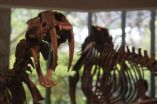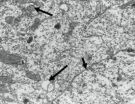(Press-News.org) WORCESTER, Mass. – New research from scientists at the University of Massachusetts Medical School shows that fruit flies are secretly harboring the biochemistry needed to glow in the dark —otherwise known as bioluminescence.
The key to activating this latent ability is a novel synthetic analog of D-luciferin developed at UMMS. The findings, published in the journal Proceedings of the National Academy of Sciences, suggest that the inherent biochemistry needed for bioluminescence is more common than previously thought. Synthetic luciferins can unmask latent enzymatic activity capable of producing light in animals not known for their luminescence. This expands the scope of bioluminescence imaging for research, and adds new tools for the noninvasive studying of ongoing biological processes.
Few animals can naturally glow in the dark. The best known example, the firefly, creates bioluminescence when the small molecule D-luciferin is oxidized by the enzyme luciferase, which is only found in beetles.
The luciferase enzyme is believed to have evolved from the fatty acyl-CoA synthetases (ACSLs) found in all insects. Both classes of enzymes are members of the adenylate-forming superfamily and can activate fatty acids. But only luciferase catalyzes light emission from D-luciferin. Stephen C Miller, PhD, associate professor of biochemistry and molecular pharmacology at UMass Medical School, had previously found that some mutations in the luciferase enzyme reduce light emission from the natural D-luciferin substrate, but improve light emission when using synthetic luciferins developed in his lab.
"This suggested to us that the failure of insect ACSLs to emit light with the beetle luciferase substrate D-luciferin didn't necessarily mean they weren't capable of the biochemistry needed to glow," said Dr. Miller, senior author of the PNAS study.
He hypothesized that ACSL enzymes in other insects are capable of a bioluminescent reaction similar to the firefly. The key was finding a small molecule to fill the role of D-luciferin, which is not a substrate for ACSLs, to kick start the biochemical reaction.
Suspecting that D-luciferin was in fact a poor substrate for ACSLs due to its shape, Miller and colleagues David Mofford, a fourth year doctoral candidate in the Graduate School of Biomedical Sciences and first author of the study and Randheer Gadarla, PhD, postdoctoral research fellow, tested a number of synthetic luciferins he had developed to see if they had the geometry necessary to initiate bioluminescence using the fatty acyl-CoA synthetase CG6178 found in the fruit fly Drosophila melanogaster.
Miller found that when this fruit fly protein was treated with a rigid synthetic analog of D-luciferin, named CycLuc2, it emitted a red glow. Simply adding CycLuc2 to live Drosophila cells was sufficient to make them glow as well. When CG6178 was expressed in mammalian cells, they too were able to emit light in the presence of CycLuc2.
"We think the unique rigid and asymmetric ring structure of the synthetic CycLuc2 molecule acts as a handle to help properly align it within the enzyme so adenylation can occur. Once that happens, the molecule can be oxidized to emit light," said Miller. "D-luciferin doesn't fit properly so the biochemical reaction necessary to initiate bioluminescence can't get started."
These findings suggest that other bioluminescent enzymatic activities may already exist in nature, waiting to be revealed by a suitable luciferin analog. Having multiple luciferases with unique substrates increases the amount of information that can be gained using this technique. And because it doesn't require changing the underlying DNA, utilizing endogenous proteins as luciferases could greatly impact the potential uses of bioluminescence imaging to study gene expression, understand infection, track cancer cells, or gauge the effectiveness of new drugs.
"These synthetic substrates expand the scope of bioluminescence beyond what was previously thought possible," said Miller. "It's going to give scientists new tools to study fundamental biological processes noninvasively in live cells and animals, possibly using an endogenous enzyme rather than firefly luciferase."
One of the next steps for Dr. Miller and colleagues will be exploring whether synthetic luciferins can unmask latent luciferase activity in human ACSL enzymes.
INFORMATION:
About the University of Massachusetts Medical School
The University of Massachusetts Medical School (UMMS), one of five campuses of the University system, comprises the School of Medicine, the Graduate School of Biomedical Sciences, the Graduate School of Nursing, a thriving research enterprise and an innovative public service initiative, Commonwealth Medicine. Its mission is to advance the health of the people of the Commonwealth through pioneering education, research, public service and health care delivery with its clinical partner, UMass Memorial Health Care. In doing so, it has built a reputation as a world-class research institution and as a leader in primary care education. The Medical School attracts more than $240 million annually in research funding, placing it among the top 50 medical schools in the nation. In 2006, UMMS's Craig C. Mello, PhD, Howard Hughes Medical Institute Investigator and the Blais University Chair in Molecular Medicine, was awarded the Nobel Prize in Physiology or Medicine, along with colleague Andrew Z. Fire, PhD, of Stanford University, for their discoveries related to RNA interference (RNAi). The 2013 opening of the Albert Sherman Center ushered in a new era of biomedical research and education on campus. Designed to maximize collaboration across fields, the Sherman Center is home to scientists pursuing novel research in emerging scientific fields with the goal of translating new discoveries into innovative therapies for human diseases.
Researchers show fruit flies have latent bioluminescence
New findings hold promise for expanded use of bioluminescence imaging tools
2014-04-10
ELSE PRESS RELEASES FROM THIS DATE:
Coral reefs of the Mozambique Channel a leading candidate for saving marine diversity
2014-04-10
Marine scientists keen on finding patterns of coral decline and persistence in gradually warming oceans have a complex challenge: how to save reefs containing the most diversity with limited resources. In the Western Indian Ocean, researchers from the Wildlife Conservation Society, the University of Warwick, the ARC Centre for Excellence of Coral Reef Studies, Simon Fraser University, University of North Carolina at Chapel Hill, and other groups have found that the corals of the Mozambique Channel should be a priority for protection as climate change continues to threaten ...
Reef fish arrived in 2 waves
2014-04-10
The world's reefs are hotbeds of biological diversity, including over 4,500 species of fish. A new study shows that the ancestors of these fish colonized reefs in two distinct waves, before and after the mass extinction event about 66 million years ago that wiped out the dinosaurs.
Reef fish represent one of the largest and most diverse assemblages of vertebrates, according to Samantha Price, a postdoctoral researcher in the Department of Evolution and Ecology at UC Davis. Price is first author on a paper describing the work, published April 2 in the journal Proceedings ...
CU researchers unraveling what's behind the sniffles, hoping for a treatment
2014-04-10
Scientists at the University of Colorado School of Medicine have shed light on one of the most common of ailments – the runny nose.
Your respiratory tract is under constant attack and the nose is the first line of defense. Often, especially as the weather warms, the assault comes from allergens, which cause the body to fight off a perceived threat. Infections, too, are a problem.
But millions of people get a runny nose and have difficulty breathing without an allergic attack or infection. What many people call the sniffles, scientists refer to as "non-allergic rhinitis."
Although ...
China looks to science and technology to fuel its economy
2014-04-10
Maintaining stability in the face of rapid change and growth, and proactively partaking in cooperative global ties in science and technology fields will be key in helping China become an innovation-based economy, according to Denis Simon, vice provost for International Strategic Initiatives at Arizona State University.
One of the world's leading experts on science, technology and innovation in China, Simon recently hosted an ASU conference that focused on the evolving role of science and technology in China's international relations.
Supplemented with strategic investments ...
Researchers looking to create new bone tissue generation technique
2014-04-10
UT Arlington and Texas Health Arlington Memorial Hospital are investigating whether bone grown from the body's own stem cells can replace traditional types of bone grafting.
The process, which has been successful in previous lab experiments, uses biodegradable polymer scaffolding material and bone morphogenetic protein, or BMP, which was inserted into the abdomen of mice to attract stem cells that in turn produced bone. BMPs are proteins known to promote bone growth. The research is detailed in a new paper, "Tissue Engineering Bone Using Autologous Progenitor Cells in ...
La Brea Tar Pit fossil research shows climate change drove evolution of Ice Age predators
2014-04-10
LOS ANGELES — Concerns about climate change and its impact on the world around us are growing daily. New scientific studies at the La Brea Tar Pits are probing the link between climate warming and the evolution of Ice Age predators, attempting to predict how animals will respond to climate change today.
The La Brea Tar Pits are famous for the amazing array of Ice Age fossils found there, such as ground sloths, mammoths, and predators like saber-toothed cats and powerful dire wolves. But the climate during the end of the Ice Age (50,000-11,000 years ago) was unstable, ...
Acupuncture normalizes brain structure and damaged neurons following heroin relapse
2014-04-10
Heroin abuse can damage many brain areas, including the pedunculopontine tegmental nucleus of the midbrain, the ventral tegmental area, and nucleus accumbens. Persistent use of heroin induced irreversible damage to the nervous system. To verify the relationship between acupuncture, neurotrophic factor expression and brain cell structural changes, a research team from Anhui University of Chinese Medicine in China established a rat model of heroin relapse using intramuscular injection of increasing amounts of heroin. During the detoxification period, rat models received acupuncture ...
Brainy courage of the rainbowfish
2014-04-10
The boldest black-lined rainbowfish are those that are born in the wild. Also more fearless are those that analyze information both sides of their brains. This is the conclusion of Australian researchers Culum Brown and Anne-Laurence Bibost from Macquarie University, in a study published in Springer's journal Behavioral Ecology and Sociobiology.
The preference to analyze and react to information with either the left or right hemisphere of the brain is called cerebral lateralization, and is widespread among vertebrates. Lateralization is seen in the preference of humans ...
Identified epigenetic factors associated with an increased risk of developing cancer
2014-04-10
In 10% of human tumors there is a family history of hereditary disease associated with mutations in identified genes. The best examples are the cases of polyps in the large intestine associated with the APC gene and breast cancer associated with BRCA1 and BRCA2 genes. In the remaining 90% of cases are believed to have an increased risk of developing cancer in relation to genetic variants less powerful but more often, for example, doubles the risk of having a tumor that lacks this small change, called polymorphism.
In the last decade, hundreds of studies have been conducted ...
Experts disagree on horses with incoordination
2014-04-10
A trip to the veterinarian may prove fatal to a horse, even if it is not necessary to put the animal down. In Europe if the horse is found to be ataxic, which is most often due to the disease 'wobbler syndrome', the horse is likely to be put down immediately. If a horse suffers from this disease, putting it down can be a necessity, as the animal can be dangerous to ride and handle. But now new research from the University of Copenhagen and the Royal Veterinary College in the UK shows marked disagreement among experts about when a horse is ataxic and severity of the ataxia. ...
LAST 30 PRESS RELEASES:
Jeonbuk National University study shows positive parenting can protect adolescents against self-harm
Surface-engineered ZnO nanocrystals to tackle perfluoroalkyl substance contamination
This new understanding of T cell receptors may improve cancer immunotherapies
A new fossil face sheds light on early migrations of ancient human ancestor
A new immunotherapy approach could work for many types of cancer
A new way to diagnose deadly lung infections and save lives
40 percent of MRI signals do not correspond to actual brain activity
How brain-inspired algorithms could drive down AI energy costs
Gum disease may be linked to plaque buildup in arteries, higher risk of major CVD events
Contrails are a major driver of aviation’s climate impact
Structure of dopamine-releasing neurons relates to the type of circuits they form for smell-processing
Reducing social isolation protects the brain in later life
Keeping the heart healthy increases longevity even after cancer
Young adults commonly mix cannabis with nicotine and tobacco
Comprehensive review illuminates tau protein's dual nature in brain health, disease, and emerging psychiatric connections
Book prepares K-12 leaders for the next public health crisis
Storms in the Southern Ocean mitigates global warming
Seals on the move: Research reveals key data for offshore development and international ecology
Sports injuries sustained during your period might be more severe
World's first successful 2 Tbit/s free-space optical communication using small optical terminals mountable on satellites and HAPS
Can intimate relationships affect your heart? New study says ‘yes’
Scalable and healable gradient textiles for multi‑scenario radiative cooling via bicomponent blow spinning
Research shows informed traders never let a good climate crisis go to waste
Intelligent XGBoost framework enhances asphalt pavement skid resistance assessment
Dual-function biomaterials for postoperative osteosarcoma: Tumor suppression and bone regeneration
New framework reveals where transport emissions concentrate in Singapore
NTP-enhanced lattice oxygen activation in Ce-Co catalysts for low-temperature soot combustion
Synergistic interface engineering in Cu-Zn-Ce catalysts for efficient CO2 hydrogenation to methanol
COVID-19 leaves a lasting mark on the human brain
Scientists use ultrasound to soften and treat cancer tumors without damaging healthy tissue
[Press-News.org] Researchers show fruit flies have latent bioluminescenceNew findings hold promise for expanded use of bioluminescence imaging tools



